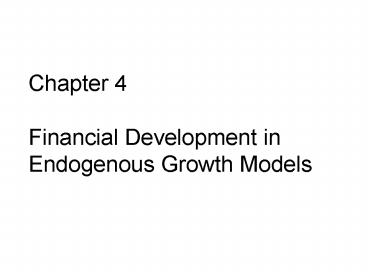Chapter 4 Financial Development in Endogenous Growth Models - PowerPoint PPT Presentation
1 / 20
Title:
Chapter 4 Financial Development in Endogenous Growth Models
Description:
Title: PowerPoint Presentation Last modified by: Jason Created Date: 1/1/1601 12:00:00 AM Document presentation format: Other titles – PowerPoint PPT presentation
Number of Views:155
Avg rating:3.0/5.0
Title: Chapter 4 Financial Development in Endogenous Growth Models
1
Chapter 4Financial Development in Endogenous
Growth Models
2
In this chapter, we mainly study the second
generation financial growth model.
- None of them attempts to combine short-run
stabilization with long run growth. - All these financial development models using
endogenous growth ignore the dynamic process of
financial liberalization or stabilization.
3
Asymmetric Information and Uncertainty
- In principle, financial contracts could be
written to deal with all future contingencies.
Such a set of state-contingent securities is
known as Arrow-Debreu securities. - The Arrow-Debreu solution can exists only if
information about all possible state of the world
is freely available and easily interpretable
monitoring must also be costless.
4
Effects of Financial Intermediaries on Portfolio
Choices
- Construct a model in which individuals can choose
between unproductive assets and an investment in
a firm. - Here young individuals work only in the first
period of their lives of a real wage and
consume only in periods 2 and 3. All young
individuals have utility function
5
- Type A individuals live three periods, while type
B individuals live only two periods. At the
beginning of age 2, individuals discover whether
they are type A individuals. - With introduction of banks, individuals can hold
deposits which banks then invest in currency and
capital.
6
- The banks maximization problem can be
illustrated in the simplest case of logarithmic
preferences (e0). In this case - Now the banks maximization problem can be
expressed - Maximize
- subject to
7
- Neither type A nor type B individuals could do
better by holding any combination of currency and
capital rather than by holding deposits. - Hence banks avoid the uncertainty which leads to
resources misallocation by individuals. By
ensuring that capital is never wasted, financial
intermediation may produce higher capital/labor
ratios and higher rates of economic growth.
8
- The existence of a stock market increases the
growth rate in comparison to a situation with on
financial intermediation. This is simply because
stock markets can prevent premature capital
liquidation by enabling individuals to sell firms
that they will be unable to operate in period 3. - However, when a stock market is compared to a
banking system, relative growth rates depend on
the degree of risk aversion.
9
- Pay attention to the transactions costs.
- First, if the cost is high enough, no one will
use the stock market and the economy returns to
financial autarky. - Second, banks need fewer financial transactions
than stock do.
10
- Reduced liquidity and productivity risks
encourage individuals to invest more in firms. In
various ways, therefore, financial institutions
can encourage individuals to invest more
resources, either directly or indirectly, in
firms. More investment in firms raises the rate
of economic growth.
11
Financial Development and Endogenous Growth
- The main feature of endogenous growth models is
that a broadly defined concept of the economys
capital stock does not suffer from diminishing
returns. One approach is to broaden the concept
of capital to include human capital or the state
of knowledge.
12
- Another of the more unrealistic assumptions in
the model is the absence of financial
intermediation costs. Rectify this by introducing
costly financial development into the endogenous
growth mode - Hence, financial development could affect growth
by influencing A, s, or µ.
13
- King and Levine (1993b) provide an alternative
way of including finance in endogenous growth
models by separating the economy into households,
financial institutions, and firms. - Overall, the evaluation and sorting of
entrepreneurs lowers the cost of investing in
productivity enhancement and stimulates economic
growth.
14
Real Interest Rate
Ramsey Curve
rl r rd
W
Romer Curves
Growth Rate
15
- In all these models, growth rate comparisons can
be made between economies with and without banks.
Relative to the situation in the absence of
banks, banks reduce liquid reserve holdings by
the economy as a whole, and also reduce the
liquidation of productive capital. Then, with an
externality in productionhigher equilibrium
growth rates with observed in economies with an
active intermediary sector
16
Financial Repression in Endogenous Growth Models
- Financial repression reduces the service provided
by the financial system to savers, entrepreneurs,
and producers it thereby impedes innovative
activity and slows economic growth.
17
Examples for financial repression
- The higher cost of evaluating and financing
entrepreneurs - Financial sector taxes
- Imposition of credit ceilings
- Government interventions such as an increase in
corporate profits tax or weakened property rights - Inflation
18
Emergence and Development of Financial Structures
- There are various rationales for the existence of
financial institutions, such as, some for of
uncertainty, costly information, transaction
costs, and economies of scale in information
collection. - Why financial intermediation emerge during the
process of economic development?
19
- Because there are fixed entry costs to
individuals who wishes to use financial
intermediaries, individuals use them only after
their incomes and wealth reach some minimum
level. Hence, in the early stages of economic
development there are virtually no financial
institutions.
20
Summary
- In contrast to the McKinnon-Shaw models, the
endogenous growth models surveyed in this chapter
provider a rationale for financial intermediation
and explain how financial intermediaries emerge. - Financial systems can encourage holdings
individuals to release their savings for
productive investment and can also improve the
allocation of investible funds.































